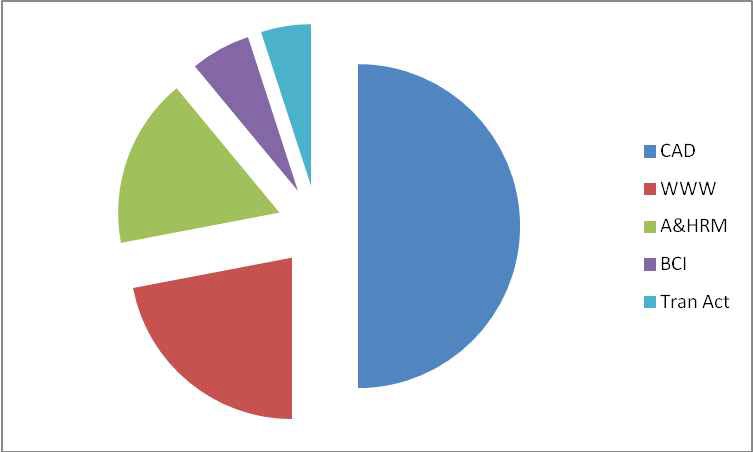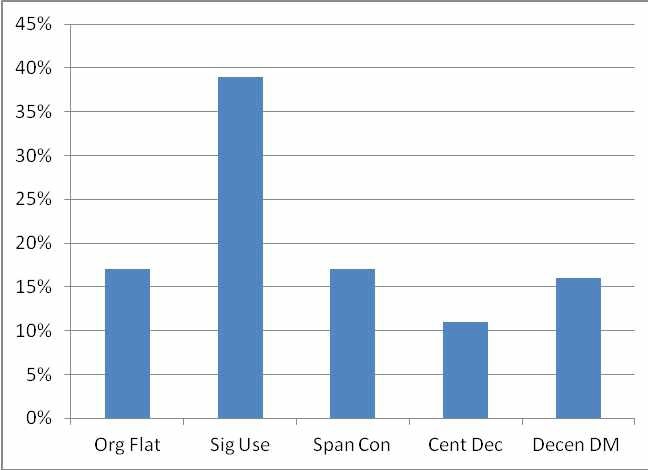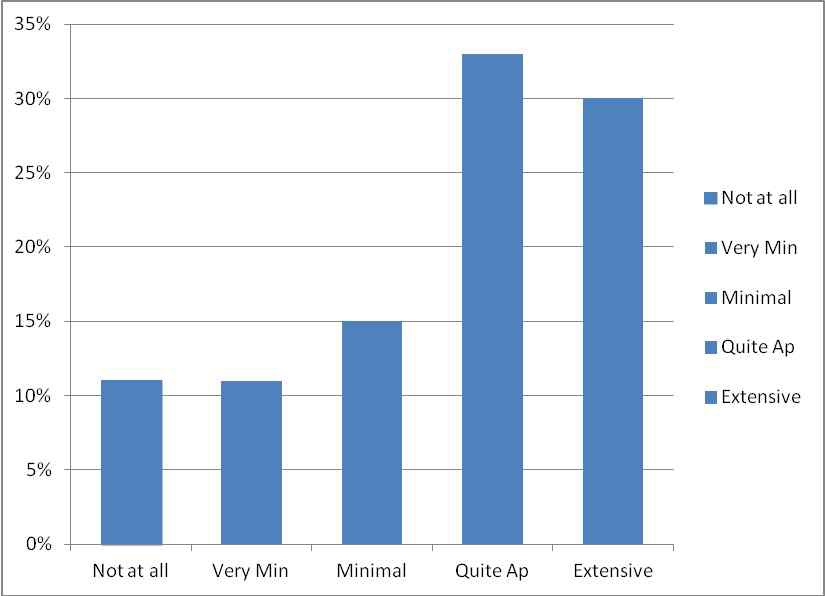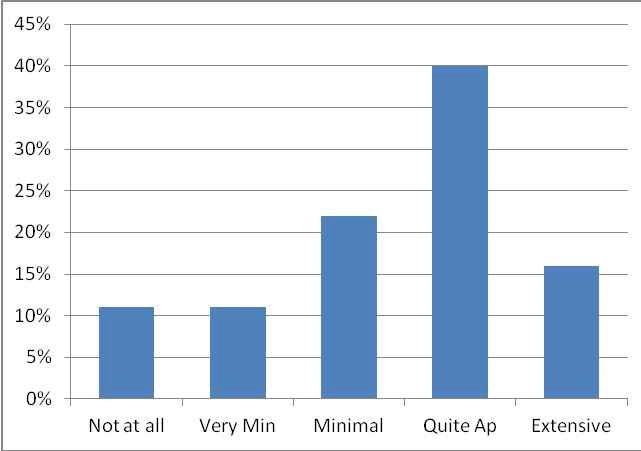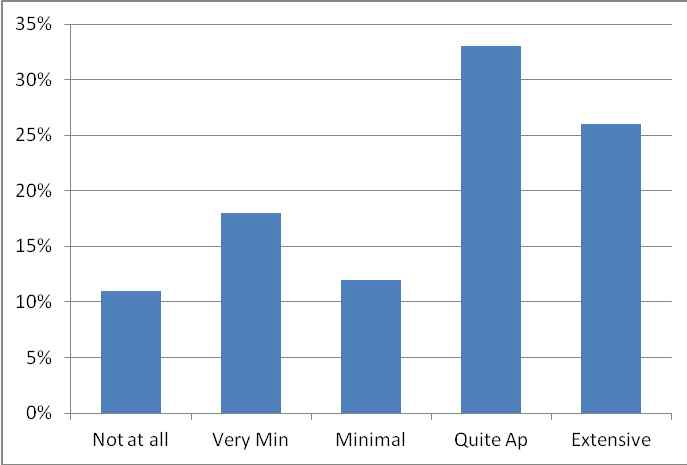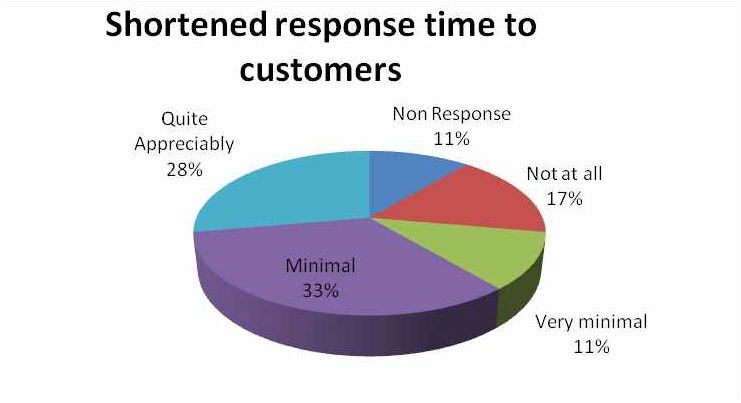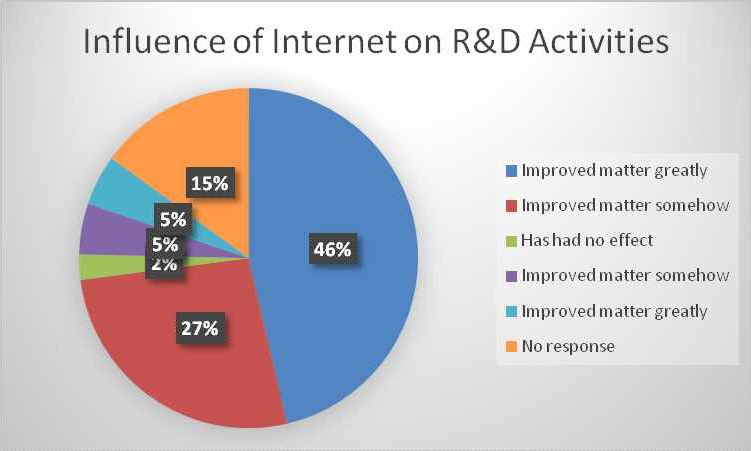



Over the last decade, the management of the research institutions in the country have clearly demonstrated their pre-disposition to investing in ICT tools to facilitate their operational activities. In all these institutions, investments have been made in computer hardware, software, development of local area networks (LANs) and wide area networks (WANs), electronic databases, computer-aided designing, and subscription to the Internet. Essentially, these are meant to enhance the effectiveness and efficiency of the institutions’ internal and inter-organizational processes. According to the National Research Council (1998), the likely impact that the Internet has had on the operations of any given organization has been a function of how that organization and individuals within it used it as well as the importance they placed on it. In the opinion of Bharadwaj (2000), investment per se does not provide any sustained advantage. Rather, it is how firms leverage these investments to create unique IT resources and skills that determine a firm’s overall effectiveness.
Generally, investments in ICT are made for different management objectives, and in the opinion of Lichtenberg (1998), the most common reasons assigned by firms, industries, financial institutions are not only to increase profit but also to reduce operational costs. In the research institutions, the investment is not only meant to facilitate the generation of new knowledge as well as make a measurable improvement in R&D activities, but also to facilitate access to up-to-date information to enhance efficient data manipulation. In these institutions, examining the applications and uses of ICT tools allow for more penetrating insight into why and how ICT has been associated with major changes in various forms of internal organizations. The use of ICT to support R&D activities has greatly influenced the way research is organized, operationalized, and evaluated. ICT tools are now being used directly as an effective coordination technology and these have had a significant impact on the cost of coordinating R&D activities within, and between institutions (Mansell & Wehn, 1998). Consequently, the adoption of ICT now remains a prime driver for R&D institutions seeking to improve their short, medium, and long-term performances.
The fact is, with globalization, research institutions have sought to increase their ICT capabilities by investing in them to enhance the effectiveness and efficiency of their internal and inter-organizational processes. The institutions now operate in new research environments and are equipped with ICT tools that facilitate knowledge flows as well as technology diffusion and absorption. The basic assumption has been that ICT tools provide virtual workspaces that do not only allow for the processing and storage of digital information, but also for retrieving it quickly and at a low cost. ICT tools are used within an organization not only to enhance its efficiency and effectiveness but also, for administrative, research, and learning activities as well as developing products and services and effectively using it as a communication tool within and beyond the institutions. The study, therefore, looked at ICT tools as the technical infrastructure that do not only provide links within the institutions but also among the institutions and the rest of the world.
Developments in ICT and its adoption and use has led to the competitiveness and economic growth of companies, organizations, and countries (Higon, 2011; Ollo-López & Aramendía-Muneta, 2012; Steinfield et al., 2012). From the resource-based view theory, firms obtain competitive advantages on the basis of harnessing corporate resources (Barney, 1991), so researchers in information system research have therefore adopted this notion and extensively used it (Santhanam & Hartono, 2003). What has emerged from these studies has been that investments in these resources did not provide a competitive advantage. Rather, it is the manner in which firms are able to leverage these investments to create unique capabilities that impact their overall competitiveness, and in so doing, enhancing their performance. In the opinion of Manochehri, Al-Esmail, and Ashrafi (2012), for a research institution to take full advantage of ICT tools there should be certain basic infrastructure as well as skilled personnel and the accompanying budget to invest in these technologies. Unfortunately, the availability of these infrastructure remains a problem to be overcome in order to derive maximum benefits from the adoption of ICT tools, Atiso and Adkin (2015). According to Bugyei, Kevi, and Obeng-Koranteng (2019), “some of the challenges associated with the use of ICT tools in the research institutions have to do with a low internet connection, lack of training and technical support”.
Generally, the ICT tools, especially, the internet does not only come as a communication tool but also serves to influence individual behavior, mindset, and even the social structure (Glassman, 2020). According to Muriithi, Horner, and Pemberton (2013), there has been increased productivity of scientific collaboration in Kenya as a result of the availability of ICT tools to the research scientists. Thus, operationally, even though the ICT tools have increased the scope, functionality, and flexibility of R&D activities, it is important that the institutions identify the critical gaps in skills and physical resources to inform the basis for guiding the choices of investments in both the technology and the accompanying human resources. With that, direct benefits could be conceptualized in terms of improved access to information and knowledge which is critical for development because everything that is done depends on it. The fact is, system usage has been widely used in management information system (MIS) empirical research and has been presented as a key component of the theoretical frameworks (Straub, Limayem, & Karahanna-Evaristo, 1995). According to them, there is widespread agreement among researchers that it is the primary variable through which information technologies affect “white color” performance. In another development, it has also been seen as a behavioral measure which is unidimensional by considering hours of use (Doll & Torkzadeh, 1998). This point was reinforced by Devaraj and Kohli (2003) when they pointed out that “system-use is a pivotal construct in the system-to-value chain that links upstream research on causes of system success with downstream research on organizational impacts of ICT”. Therefore, in the research environment, measuring the impact of ICT required measuring the extent to which the technologies were being used, and the effects arising from their utilization.
Considering the massive investments that R&D institutions are making in ICT tools, the need to assess its contribution to the performance of the research institutes has become very critical, especially in developing countries. ICT tools have increased the scope and scale of R&D activities through their contribution to accelerated S&T innovations by creating user-led innovations as well as learning communities. Even though the usage of ICT tools has been studied as a phenomenon of interest at the firm and industry levels, it is only recently that investment in these tools is being studied in service organizations. In this respect, the question that needs to be addressed is whether investing in ICT use really makes any impact on the activities of a service organization like the country’s S&T based research institutions.
The overall goal of the study was to assess ICT applications in S&T based research institutions in Ghana and their impact on R&D activities in the research institutes. It is aimed at providing an empirical analysis of the extent of deployment of ICT in the research institutions as well as their applications to which the technologies are being used for, and their effect on the performance of these institutions.
Specifically, the study seeks to:
The research questions considered for the study are:
The study used the quantitative data collection technique and it was essentially designed to use structured and semi-structured questionnaires and this allowed for the use of open-ended questions that enabled the population to discuss their perceptions and knowledge of ICT use in their institutions. This was followed with personal observations of the ICT infrastructure through visits to the research institutes as well as informal discussions with the management team comprising the directors, administrators, accountants, and IT personnel. According to Creswell (1994), this approach is generally used to gather data at a point in time with the intention of determining the relationships that exist between events. This point is further reinforced by Cohen and Manion (1999) who argued that descriptive surveys are quick and cost-effective ways of collecting data at a point in time with a view to describing the nature of an existing situation or conditions.
The study population consisted of the core research scientists in the publicly funded S&T based research institutions who have been specifically employed to undertake R&D activities. They were found to be 642 and they constituted the “knowledge workers” and therefore, are of a homogenous group. The rationale for settling on this category of staff was not only to maximize sample homogeneity in respect of the work they do but also to facilitate meaningful comparisons. This category of staff has been using ICT as working tools and they have easy access to computers, and to the Internet within their institutions compared to the other categories of staff. In determining the sample size from the total population, a table for estimating sample size developed by Krejcie and Morgan (1970) and quoted by Sarantakos (2005) was used. Thus, the required sample size was estimated to be 242, however, to ensure a fair representation of the research scientists proportionate numbers were selected from the institutes to bring the sample size to 246.
4.1 Pre-testing of the Questionnaire
The questionnaire was pre-tested on the core research scientists in three institutions of comparable status. The rationale was to check if the questions were not only understandable to answer, but also, the length, as well as the sequence be reasonable, the sensitivity, and the time needed to complete them. The institutions were the Science and Technology Policy Research Institute of CSIR, the Nuclear Research Institute of GAEC, and the Centre for Scientific Research into Plant Medicine. This was carried out in June 2018 to ascertain which of the items of the instrument were not understood or misunderstood.
Part of the precautionary measures taken before the data collection included the issuance of letters of introduction to the management of the research institutions as well as the research scientists. Furthermore, the anonymity and confidentiality of responses given by the respondents were also assured in a written form on the questionnaires.
4.3 Data Management and Analysis
The data collection spanned over two months period from August to September 2018. The questionnaire included information on their educational background, length of period that they have been using ICT tools, and their skill intensity in using these tools for R&D activities. A variety of scales were used, and these included a self-reported instrument that measured individual usage of ICT as well as productivity and job satisfaction. Respondents were instructed to indicate the extent of their agreement with each item on a 5 point Likert scale which were anchored at the ends with “strongly agree” to “strongly disagree”. In the case of use or application of technology, these were anchored by “Very frequently” to “not used”. There were open-ended and closed questions as well.
Out of 246 questionnaires administered to the research scientists, 205 responded, giving a response rate of 83.3 percent. After carefully examining them, it was realized that 8 of them were not fully completed and these were taken out leaving a total of 197 which gave a response rate of 80 percent for analysis. The data from the survey were coded and processed using the Statistical Product and Service Solutions (SPSS 20.0) and Microsoft Excel software packages. Qualitative cases were analyzed for thematic patterns and better insight while descriptive and inferential statistics were also used to analyze some of the data.
5.1 Background Characteristics of the Research Scientists
The first section of the questionnaire dealt with the profile of the research scientists and from the results obtained it was realized that this category of staff in the institutes was made up of highly educated personnel with the minimum qualification of Master of Science (MSc) or Master of Philosophy (MPhil) degree. From the data analyzed 67.30 percent of the research scientists sampled had MSc or MPhil degrees, and the majority of them were at various stages of their Ph.D. programs, while 30.20 percent had the terminal degrees (Ph.D.). Out of the population sampled 2.50 percent of them failed to indicate their qualifications. The distribution of positions of the respondents also came out with 65.30 percent being Research Scientists while the next higher grade made up of Senior Research Scientists constituted 20.30 percent. The Principal Research Scientists were 7.60 percent while those who had reached the pinnacle of their career, the Chief Research Scientist grade was 4.50 percent. Once again, 2.50 percent of the respondents failed to indicate their grades. Thus, as one climbed the professional ladder the pyramidal structure became more prominent with few of the core research scientists making it to the top-most grade.
5.2 Availability of ICT Infrastructure
Research institutions are primarily concerned with the generation of knowledge and innovative technologies as well as their dissemination. These institutions have been investing in ICT tools with the expectation that it will contribute to increased productivity and enhanced organizational performance. In this respect, the second portion of the management questionnaire comprising 8 questions looked at the ICT infrastructure in the institutions. The rationale was that in a research institution the use of the computer and other ICT tools like the Internet has become an integral part of the scientist’s working tools. Therefore, the presence of good quality ICT infrastructure, especially Internet connectivity, has had a direct bearing on the productivity of the research scientists, and the overall performance of their institutions.
From the study, it was realized that almost all the research institutions had put in place some ICT infrastructure. These physical ICT assets comprised the fixed telephone, facsimile, computers, and Internet technologies. All the research institutions had in place telephone systems which they had relied on as the basic communication tool over a long period of time. This reinforces the point made by Gillwald and Stork (2008) that telephony, both fixed and mobile have become the ICT tool that is used by research scientists to communicate in developing countries. Added to these were facsimile machines which also featured prominently as communication tools for sending and receiving messages. Finally, the institutions were seen to have invested in computer laboratories and Internet technologies.
To appreciate what ICT access meant to the research institutions, the study considered computing facilities in relation to the total number of staff in the institutes. From the data in Table 1, the Noguchi Memorial Institute for Medical Research had the highest computer to research scientist ratio of 4.34 while GAEC had the least of 0.52. The results suggested that the research scientists had access to computers as their working tool within their institutions (approximately one computer to one research scientist). Quite apart from what the institutions had provided, it came out clearly that almost all the research scientists had their personal computers. This was possible because some of them indicated that they were using computers bought with project funds. Again, the majority of the research scientists also indicated that they had their own desktop computers at home which they used for official purposes. Thus, access to computers whether at home or the workplace was important because these are currently the dominant mechanism by which individuals gained access to the Internet.
[Table 1.] Computer to Staff Ratio in the Research Institutes
Computer to Staff Ratio in the Research Institutes
From the inspection carried out on the physical infrastructure available in these institutions, it was realized that all the research institutes were networked into individual campus-wide institutional local area networks (LANs). Furthermore, they were connected to the Internet via servers linked to Internet Service Providers (ISPs).
In the case of the CSIR institutes, quite apart from the LANs in the various institutions, the organization had also put in place an enterprise-wide backbone network that inter-connected all the institutes into a wide area network (WAN). The rationale for setting up the WAN was to provide a common platform for implementing organizational-wide applications like Management Information System (MIS) as well as other electronic platforms that could be linked to other applications for data and information interchange and processing to support the administrative activities at the corporate level. As far as the other research institutions were concerned, the installation of LANs and WANs had greatly facilitated both intra- and inter-organizational communication among the research scientists. This was attested to when almost all of them indicated that they regularly sent and received mails from their colleagues within the institutions and those outsides with whom they are collaborating with on some of the projects.
The ability of the institutions to derive full benefit from investment in ICT depends on their networking infrastructure. According to (Hammer, 2001; Straub & Watson, 2001), research has shown that in the network environment, electronic linkages within and among organizations have proliferated and these have altered the ways in which the firms acquired factor inputs, convert them into products and services, and distributed the results. In the study, it was observed that the ICT facilities in the research institutions were not only relatively under-developed but also the sizes of bandwidth that they subscribed to were comparatively small. The challenge associated with low bandwidth sizes in research institutions has been confirmed in similar studies carried out by Atiso and Adkins (2015).
Generally, researchers need fast Internet connectivity to enable them to collaborate effectively with their peers across the globe. However, in the case of the research institutions studied it had not been possible to put in place high-speed Internet access due to lack of funds. The study revealed that the common access methods were through a modem, leased lines, broadband, and VSAT, and the bandwidth varied from 256 kbps to 10 MB.
Respondents to the survey commented that “poor connectivity including slow speed and dropping connections frustrated their attempts to access the Internet”. As high as 73 percent of the research scientists commented that “the Internet connectivity was very slow during the day”. It is important to point out that connectivity is not simply a matter of total bandwidth available, but also the number of users this must serve, and it came out clearly from the study that the Internet facilities were heavily used by all the staff in the respective institutions.
The nexus between broadband access and R&D activities has gradually become very important, in that, Internet access has been playing a major role in enhancing R&D activities, and this has driven innovation activities. This reinforces the view of Kleis et al. (2012), who opined that ICT use contributes to improvement in the management of the knowledge used in the innovation process. This in turn encourages robust and thriving economies which eventually makes them more competitive in today’s global economy (Dahlman & Aubert, 2001). Even though the argument supporting widespread broadband access can sometimes get blurred because connectivity does not always translate to adoption or usage of technology, increasing bandwidth ultimately strengthens the institutes’ R&D activities and provide them some competitive advantage. Clearly, the major constraint which was found to be militating against investing in ICT tools as far as the research institutions are concerned was lack of funds and this was reflected in the size of bandwidths that they subscribed to.
Generally, the contribution of ICT tools, especially computers, to research institutions has progressed from data processing to the current applications. At the institutional level, it was observed that the management of ICT facilities has been a partnership between the top management on the one hand, and the IT staff. According to the Directors of the institutes, their involvement in the management of these facilities could be attributed to the fact that due cognizance has to be taken of the institutional goals which they have to ensure that they are achieved.
The study, therefore, assessed the technical support services in the institutes and found that eight of them had system analysts; another 10 had either one or two network engineers; then eight had computer technicians; two had telecommunications specialists while only one had a program and/or software developer. From discussions with the Directors of these institutes, it came to light that almost all of them out-source the repairing, servicing, and maintenance of the equipment to IT service providers. Certainly, since an institution’s ability to rapidly develop and deploy critical ICT tools depends on the availability of skilled internal IT workforce, it is important that the current IT staff strengths in these institutions should be beefed up. This observation is in tandem with the observation of Henderson (1990) that “an organization’s inability to integrate the use and management of its IT infrastructure into its mainstream operations will fail to realize the requisite benefits from the investment made”.
In the study, when the research question as to what informed the decision of R&D institutions to invest in ICT was examined on an institutional basis the results obtained demonstrated that even though almost all of them had invested in these tools, clearly increasing profit or reducing cost did not feature prominently in their considerations as it was with the case of industries and financial institutions. Thus, as far as the S&T based research institutions were concerned it was an issue such as making measurable improvement in the quality of R&D activities which was considered more important by 37 percent of the management teams of those institutions. A further 22 percent of them considered generating new knowledge to be important and therefore influenced their decisions when it came to investment in the technologies. The other issues that were given equal prominence by 15 percent of the management teams were facilitating access to new knowledge and enhancing efficient data management. Finally, the issues that were considered least important were reducing the cost of operations, 6 percent, and increasing profit, 5 percent.
Clearly, the study did not support Lichtenberg’s (1998) assertion that decisions to invest in ICT were traditionally focused on technological and financial issues. Rather, the study supported the view that the decision to invest in ICT greatly depended on what the institutes wanted to do with the tools, vis-à-vis, their mandates as well as the activities they were engaged in. This was in tandem with the findings of Ryan and Harrison (2000) who investigated the relationship between the social sub-system costs and IT decisions by interviewing 50 IT decision-makers.
5.6 ICT Implementation Strategy
The adoption of ICT in the research environment offers several gains which include improvement in product quality; product differentiation and better management control. Therefore, in order to identify the crucial factors out of several plausible variables, the Directors and ICT experts in the research institutions were asked whether their institutes had ICT strategy. On this issue, 56.25 percent of the respondents indicated that they had ICT strategy while 43.75 percent of them did not have any. As a follow-up question, the research institutes which indicated that they had ICT strategies were asked to indicate the timeframe within which these strategies were renewed, and it was realized that 50 percent of them had not revised their policies since they were put in place over a decade ago.
The study also considered the important factors that guided them in the implementation of the ICT projects. In this case, the respondents were specifically presented with six issues, and each was rated on a four point Likert scale according to the degree to which it was addressed within the ICT strategy from (1 = Not at all; 2 = Minimal; 3 = Appreciably 4 = Extensively).
Below are the issues that were presented to them which were expected to have been considered in the implementation of an ICT project of this nature:
According to the results, the issue that was considered topmost by the respondents to the question was user training, and as much as 53 percent of the respondents found the issue to be appreciably and extensively important. The next issue that was considered was whether an implementation project management team was put in place. As much as 43.8 percent indicated that the putting in place of the project implementation team was important. On the issue of benefits to be derived from the project, 41.2 percent considered it to be appreciably and extensively relevant. Finally, on the issue of the correct mix of skills available, 41.1 percent considered it to be important and therefore had to be taken into consideration during the implementation of the ICT project. Obviously, this was not out of place since the institutions did not have the correct mix of staff at post and, therefore, had to rely on consultants to put in place their ICT infrastructure. Probably, if they had the correct mix of staff to enable them to implement the projects themselves then the issue of post-implementation review process could have also been addressed.
To appreciate and truly understand the extent to which the ICT tools deployed were being used for in various aspects of the institutes’ work, the respondents were made to indicate on a 5 point Likert scale (from 1 = Not at all to 5 = Extensively) the uses to which the ICT was put in their institutes. The issues involved with respect to this question were for:
The responses obtained were depicted in a pie chart in Fig. 1 to display the extent of diversity as to how ICT tools were being used by the research scientists in their institutions. Clearly, from the data gathered, the ICT was being extensively used for computer-aided designing (CAD) and this was made up of 50 percent of the respondents. Next in order of importance as far as usage was concerned related to accessing the World Wide Web (WWW) and 22 percent of the respondents were involved while 17 percent of the institutions surveyed used the ICT facilities for administrative and human resources management (A&HRM) activities. The remaining six percent used it as an infrastructure for communication (BCI) and five percent for transactional purposes (Tra Act).
From the data gathered, it came out clearly that the R&D institutions used the ICT tools mostly for computer-aided designing, and to access the World Wide Web. This was obviously not surprising since, for research institutions, these activities occupied a premium place and were found to be consistent with what Raymond, Pare, and Bergeran (1995), and Tam (1998) found in their studies. As far as accessing the WWW was concerned it turned out that the electronic mail was widely used for both official and unofficial communication at the individual and institutional levels. The manner in which the individual research scientists and the research institutions used the Internet was considered and Table 2 gives a clear indication. Finally, it was found that within all the S&T research institutions the ICT tools have provided the research scientists with “virtual” workspace to enable them to participate in remote workgroups as well as efficient communication corridors to enable them to access digital resources and to exchange e-mails with their colleagues.
Extent of Usage
5.8 ICT and Institutional Management
Whatever success an organization achieves from applying ICT and reaping maximum benefits or payoffs from the investment require reasonably good management. Therefore, since improved service quality is often one of the most important outputs of IT systems, the study measured the extent to which ICT has helped in managing the institutes. The rationale for the inquiry was to provide practical insights into the likely impact of ICT tools on organizational performance. Thus, in the questionnaire administered to the management team, respondents were asked to indicate on a five-point Likert scale (with anchors ranging from “Not at all” to “Extensively”) the extent to which ICT has facilitated organizational performance. The issues considered were that ICT has facilitated:
From the responses obtained from the data as presented in Fig. 2, it clearly showed that ICT has facilitated the significant use of self-directed teams in the research institutes. That apart, all the issues presented were found to be equally important in as far as the management teams of the institutes were concerned. This has allowed for institutional flexibilities and reinforced the point made by Grant (1991) that the adaptability of employees to organizational change is one factor that determines the strategic flexibility of a firm.
The study then assessed the major expectations for implementing the ICT projects by asking the management of the research institutions to indicate on a five-point Likert scale (with anchors ranging from “Not at all” to “Extensively”) their major expectations for investing in ICT. The issues considered were to:
From the data gathered 11 percent of the management staff did not expect that in implementing the ICT project it will improve the productivity of the research scientists. An equal percentage of them thought that it will have a very minimal effect while 15 percent of them thought the project will have minimal effect. Another 33 percent of the staff surveyed responded that they expected the project to have quite an appreciable effect on the research scientists while 30 percent of them thought the implementation of the project will have extensive improvement on the productivity of the research scientists.
According to the results displayed in Fig. 4 below, 40 percent of the respondents indicated that the research institutes invested in ICT with the expectation that it will help improve the product development and service delivery timescale quite appreciably while 16 percent expected extensive improvements. Meanwhile, an equal percentage of them (11%) did not expect any improvement at all or did expect very minimal improvement while 22 percent expected minimal improvement in the product development and service delivery timescale.
On the issue of enhancing the development of new products, the results displayed in Fig. 5, indicated that 11 percent did not expect anything at all with respect to enhancement in the development of new products while 18 percent expected very minimal enhancement. Another 12 percent expected minimal change while 33 percent expected quite an appreciable enhancement in the development of new products and the remaining 26 percent expected an extensive enhancement of the development of new products.
In Fig. 6, the issue of expected shortening of response time to customers with the implementation of the project was considered, and 28 percent did indicate that they expected quite an appreciable reduction in response time to customers while 33 percent expected a minimal reduction. Another 11 percent expected very minimal reduction while 17 percent did not expect any reduction at all. Finally, another 11 percent did not respond to the question at all.
Finally, the issue of the transformation of the Institutes through the forging of strategic partnerships with the implementation of the project was considered and 50 percent of the respondents expected quite an appreciable transformation. Another 22 percent did expect minimal transformation while 11 percent responded that they expected very minimal transformation of the institutes through forging of strategic partnerships. The remaining respondents made up of 6 percent did not respond to the questions as shown in Fig. 7.
5.9 Influence of Internet on Professional R&D Activities
The study assessed the influence of the Internet on the professional R&D activities of the research scientists and out of the total respondents, 46 percent of them representing 96 respondents indicated that this has greatly improved matters for them. Another 27 percent, representing 55 research scientists, indicated that the Internet has somehow improved matters for them as far as their R&D activities are concerned. An equal number representing 10 each of the respondents (i.e.5 percent) indicated that the Internet has greatly improved matters or somehow improved matters respectively for them. Somehow, 2 percent of them indicated that it has. had no effect on their R&D activities. Unfortunately, 15 percent of them made up of 31 research scientists failed to respond to this question.
At the institutional level, ICT infrastructure and IT staff play a very important role in the provision of fast and reliable Internet access. From the data gathered, it was realized that Internet connectivity and the size of bandwidth that the R&D institutions subscribed to differed significantly. Many of the respondents to the survey questionnaire as well as the discussions that the researcher had with the Directors and IT experts in the institutions brought out such comments as the poor Internet connectivity because of slow speeds, dropping connections, and other related problem such as intermittent power supply frustrated their attempt to access the electronic databases and other resources that the institutes had provided. The study showed that the extent to which the research scientists were able to access the Internet in their respective institutions depended on the quality of the local networks that have been put in place.
